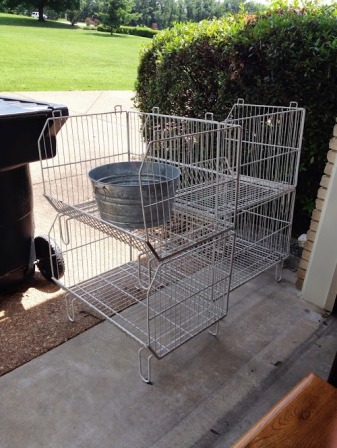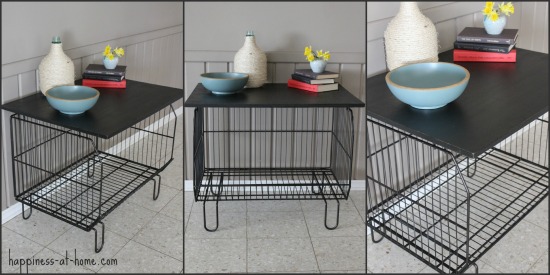I have a garage full of projects just waiting for me to jump back in – furniture to be refinished, items to be repurposed, and a few things that need a major overhaul. Slowly but surely, I’m coming out of a long winter’s hibernation (and getting out of the kitchen a bit!), and I am so excited to get my hands back on my sander and paintbrush.
I picked back up where I left off last year, with an idea to turn a sturdy wire storage bin into a cool, industrial-like side table. I snagged several of these storage bins after one of my craigslist searches for anything that catches my eye. A warehouse here in town was cleaning out, and I cleaned up!

Original purpose – stack them up in your garage for storage. Me – add a table top and have a cool place to stash kid’s toys. My intention is actually to use it as a TV stand in our playroom and toss in the Kiddo’s various bits of sports equipment, but until I give the playroom a major renovation, you won’t be getting a picture of that anytime soon.
I’m really happy with the result, and think this will be a versatile piece that I can move around where needed. For an easy DIY project, it’s a keeper. Here’s my how-to:
- I spray painted the wire crate with Krylon Oil Rubbed Bronze. I love how it looks, but if I do another one, I’ll seriously consider just touching up the white color that’s already there. With a wire crate, there was so much waste of spray paint, that I’m not sure it was worth trying to change the color.
- I measured the size of the top I needed, and then went to my favorite Home Depot and purchased a 3/4″ thick piece of pre-sanded plywood. I had them make a couple of cuts for me, and then my handy dad was nice enough to make a couple more.
- When I brought my table top home, I went ahead and sanded it even though it was a pre-sanded piece. I wanted to make sure it was nice and smooth, and the rough edges from the cuts needed a little attention. I used a 100 grit sandpaper.
- The table top was painted with 2 coats of flat black (my favorite black is Black Suede by Behr), and then lightly sanded with a 220 grit sandpaper. I did a little more on the edges and corners to give it a distressed look. Then I wiped it all down with a damp cloth.
- I wiped a Golden Pecan stain over the entire table top piece and let it dry overnight. Then I used a wipe on Polyurethane (2 coats) to seal it. The black distressed paint with a light stain looks great with the oil rubbed bronze color of the crate.
- Finally, I was ready for assembly! I used U-shaped brackets from the closet section of the hardware store to affix the underside of the table top to the wire crate. And done!
The 3/4″ plywood is sturdy enough to hold our TV and the storage works great for larger toys. I may go ahead and do another one for a bed-side table when we change over to a “big boy bedroom” for the Little Man.





















